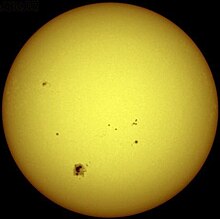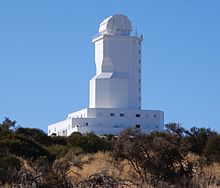Kiepenheuer Institute for Solar Physics
| Kiepenheuer Institute for Solar Physics | |
|---|---|
 Main building of the institute |
|
| Category: | research Institute |
| Carrier: | legally independent |
| Membership: | Leibniz Association |
| Facility location: | Freiburg in Breisgau |
| Branch office: | Observatorio del Teide , Tenerife |
| Type of research: | Basic research |
| Subjects: | Natural sciences |
| Areas of expertise: | Astronomy , astrophysics , solar physics |
| Basic funding: | Federal government (50%), states (50%) |
| Management: | Svetlana Berdyugina |
| Employee: | approx. 83 |
| Homepage: | www.leibniz-kis.de |
The Kiepenheuer Institute for Solar Physics (KIS) is a non-university research facility based in Freiburg im Breisgau . His research activities can be assigned to application-oriented basic research in the fields of astronomy , astrophysics and solar physics . The institute is a foundation under public law of the state of Baden-Württemberg and is a member of the Gottfried Wilhelm Leibniz Scientific Association (WGL).
history
The establishment of the institute dates back to 1939, when Karl-Otto Kiepenheuer (1910 to 1975) joined Johannes Plendl with whose help he set up a network of (militarily manned) observation stations for solar activity, including an observatory on the Schauinsland . The aim was to investigate the influence of the variable activity of the sun and solar eruptions on the ionosphere . It was hoped that this knowledge could be used in the transmission of shortwave messages . The institute originally had the name "Fraunhofer Institute". There was no connection with the institutes of the Fraunhofer Society , which was later founded .
After the end of the Second World War , the observatory on the Schauinsland remained the headquarters of the institute, in 1955 the institute moved to Freiburg and in 1978 it was renamed the “Kiepenheuer Institute for Solar Physics”.
Until December 31, 2001, the Kiepenheuer Institute was a legally dependent, non-university research institution of the state directly subordinate to the Ministry of Science of the State of Baden-Württemberg. On January 1, 2002, following a recommendation by the Science Council, the company was converted into a foundation under public law of the state of Baden-Württemberg.
tasks
The Kiepenheuer Institute conducts experimental and theoretical research into physical processes on and in the sun .
The research topics of the institute are: Fine structure of convection and magnetic field of the solar surface; Structure and structure of sunspots in the 22-year magnetic cycle ; Solar corona . The system of magnetism of the sun plays the connecting role. In addition, the instrumental development for the observatory is one of the tasks of the institute.
The institute continues to operate the old solar observatory on the Schauinsland near Freiburg. The scientific observations of the sun usually take place with German telescopes in the Observatorio del Teide on Tenerife , which was built between 1986 and 1988 .
The institute consists of two scientific departments:
- Theoretical solar physics ,
- Experimental solar physics.
The scientists of the Kiepenheuer Institute participate in the physics faculty of the Albert-Ludwigs-Universität Freiburg in the training of students, diploma students and doctoral students.
Observatories
Together with the Institute for Astrophysics at the University of Göttingen , the Leibniz Institute for Astrophysics Potsdam and the Max Planck Institute for Solar System Research in Katlenburg-Lindau , the KIS operates several solar telescopes in the Spanish Observatorio del Teide on Mount Izaña on Tenerife .
The main telescope there is the Vacuum Tower Telescope (VTT) with an aperture of 70 centimeters and a focal length of 46 meters, in which a coelostat system is used to feed in light. The VTT has a vertically installed Echelle spectrograph with a focal length of 15 meters (or 7.5 meters) , a filter system for the simultaneous recording of images of the sun in different wavelengths and an optical laboratory with a Fabry-Pérot interferometer .
On the Schauinsland there is a tower telescope (refractor) with an opening of 45 centimeters, which, like the VTT, is equipped with a coelostat system. This observatory is used for testing equipment and for training purposes.
financing
According to the financing model of the so-called Blue List institutions, half of the institute is financed from funds from the federal government and the federal states in the form of deficit financing. The federal portion is borne by the Federal Ministry of Education and Research (BMBF), three quarters of the state portion by the Ministry of Science, Research and the Arts of the State of Baden-Württemberg . The remaining quarter of the country share is divided among all countries according to the Königstein key . In total, the institute has a budget of 3.7 million euros in the 2007 budget year.
See also
Web links
- Website of the Kiepenheuer Institute for Solar Physics
- Observatory on Mount Teide on Tenerife (English)
- Further information on the history of the institute
Individual evidence
- ↑ The name “Fraunhofer Institute” was also used by Walter Dieminger's group in the early post-war period , after William Roy Piggott had transferred it from the American to the British occupation zone .
Coordinates: 47 ° 59 ′ 54.4 " N , 7 ° 51 ′ 40.5" E


